
"I'll Be There for You" is a song by American pop rock duo the Rembrandts. The song was written by David Crane, Marta Kauffman, Michael Skloff, and Allee Willis as the main theme song to the NBC sitcom Friends, which was broadcast from 1994 to 2004. American rock band R.E.M. was originally asked to allow their song "Shiny Happy People" to be used for the Friends theme, but they turned the opportunity down. "I'll Be There for You" was subsequently written and Warner Bros. Television selected the only available band on Warner Bros. Records to record it: the Rembrandts. In 1995, after a Nashville radio station brought the song to mainstream popularity, Rembrandts members Danny Wilde and Phil Sōlem expanded the theme song with two new verses and included this version on their third studio album, L.P. (1995).

New Adventures in Hi-Fi is the tenth studio album by the American alternative rock band R.E.M. It was their fifth major-label release for Warner Bros. Records, released on September 9, 1996, in Europe and Australia, and the following day in the United States. New Adventures in Hi-Fi was the band's final album recorded with founding drummer Bill Berry, original manager Jefferson Holt, and long-time producer Scott Litt. The members of R.E.M. consider the recorded album representative of the band at their peak, and fans generally regard it as the band's last great record before a perceived artistic decline during the late 1990s and early 2000s. It has sold around seven million units, growing in cult status years after its release, with several retrospectives ranking it among the top of the band's recorded catalogue.

"What's the Frequency, Kenneth?" is a song by American alternative rock band R.E.M. from their ninth studio album, Monster (1994). The song's title refers to an incident in New York City in 1986 in which two then-unknown assailants attacked journalist Dan Rather while repeating "Kenneth, what is the frequency?"
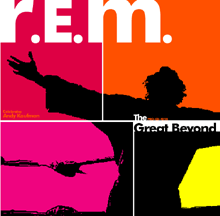
"The Great Beyond" is a song by American rock band R.E.M., written for the 1999 film Man on the Moon. It was released as a single the same year for support of the film's soundtrack album. On the soundtrack, there is some dialogue from the movie at the end of the track; meanwhile, the single version is a radio edit, with the bridge omitted.
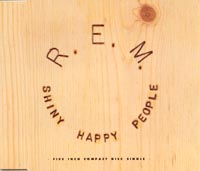
"Shiny Happy People" is a song by the American rock band R.E.M., released as the second single from their seventh studio album, Out of Time (1991). It features guest vocals by Kate Pierson of the B-52's, who also appears in the music video.

"Everybody Hurts" is a song by American rock band R.E.M. from their eighth studio album, Automatic for the People (1992), and released as a single in April 1993 by Warner Bros. Records. It peaked at number 29 on the US Billboard Hot 100, but fared much better on the US Cash Box Top 100, where it peaked at number 18. The song also reached the top 10 on the charts of Australia, Canada, France, Iceland, Ireland, the Netherlands, and the United Kingdom. Its music video was directed by Jake Scott and filmed in San Antonio, Texas. In 2003, Q ranked "Everybody Hurts" at number 31 on their list of the "1001 Best Songs Ever", and in 2005, Blender ranked the song at number 238 on their list of "Greatest Songs Since You Were Born".

"Man on the Moon" is a song by American alternative rock band R.E.M., released in November 1992 as the second single from their eighth album, Automatic for the People (1992). The lyrics were written by lead singer Michael Stipe, and the music by drummer Bill Berry and guitarist Peter Buck. The song was well received by critics and reached number 30 on the US Billboard Hot 100, number 17 on the US Cash Box Top 100, number 18 on the UK Singles Chart, and number one in Iceland. It remains one of R.E.M.'s most popular songs and was included on the compilations In Time: The Best of R.E.M. 1988–2003 and Part Lies, Part Heart, Part Truth, Part Garbage 1982–2011.
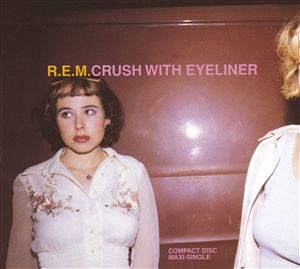
"Crush with Eyeliner" is a song by American rock band R.E.M., released by Warner Bros. Records as the third single from their ninth studio album, Monster (1994). Sonic Youth's Thurston Moore provides background vocals. Michael Stipe claims the song was inspired by the band New York Dolls, who, in his opinion, "knew how to exaggerate a song, to make it sound really sleazy and over the top." This was also one of the first songs that surfaced from Stipe after the writer's block that hounded him after the death of his friend, actor River Phoenix.

"Bang and Blame" is a song by American alternative rock group R.E.M. It was released as the second single from their ninth studio album, Monster (1994), on October 31, 1994 by Warner Bros. Records. The song was R.E.M.'s last to reach the top 40 on the US Billboard Hot 100, peaking at number 19, and was also their last number-one single on the Billboard Modern Rock Tracks chart. The single reached number one in Canada—R.E.M.'s only single to do so—and peaked inside the top 40 on the charts of Australia, Belgium, Finland, Iceland, Ireland, the Netherlands, New Zealand, and the United Kingdom.

"Strange Currencies" is a song by American rock band R.E.M. It was included on their ninth studio album, Monster (1994), and was released as the album's fourth single on April 18, 1995, by Warner Bros. Records. The song reached number nine on the UK Singles Chart and peaked at number 47 in the United States. Like "Everybody Hurts" on R.E.M.'s previous album, it has a time signature of 6
8. The song's music video was directed by Mark Romanek.

"Tongue" is a song by American rock band R.E.M., released on July 17, 1995 by Warner Bros. Records, as the fifth and final single from their ninth studio album, Monster (1994). The song was only released in the US, UK, and Ireland. In the song, lead singer Michael Stipe performs in falsetto; he has stated on several occasions that the narrator of the song is female. Stipe has also said the track is "all about cunnilingus".

"The Sidewinder Sleeps Tonite" is a song by American alternative rock band R.E.M. It was influenced by the song "The Lion Sleeps Tonight", both in the title of the song and through the song's opening refrain. The band used "The Lion Sleeps Tonight" as the B-side to this song in the U.S. The song was released on R.E.M.'s 1992 album, Automatic for the People, and was later released as a single in February 1993, reaching number one in Iceland, number 13 in Ireland, number 17 in the United Kingdom, and number 29 in New Zealand. Its music video was directed by Kevin Kerslake.

"Leaving New York" is a song by American alternative rock band R.E.M. It was released as the lead single from the band's 13th studio album, Around the Sun (2004). Although it was not as heavily promoted as earlier singles, it reached number five on the UK Singles Chart, becoming their 11th and final top-10 hit there. However, the song failed to chart on the Billboard Hot 100, becoming the only lead US single from an R.E.M. studio album not to chart on the US Hot 100 besides "Cant Get There from Here" from Fables of the Reconstruction in 1985.
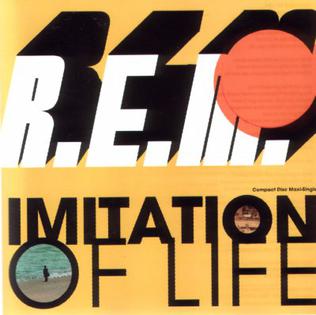
"Imitation of Life" is a song by American alternative rock band R.E.M. It was written by band members Peter Buck, Mike Mills, and Michael Stipe and produced by the band with Pat McCarthy for their 12th studio album, Reveal (2001). The track's title comes from Douglas Sirk's 1959 film of the same name and is used as a metaphor for adolescence and adulthood. One of R.E.M.'s most pop-influenced tracks, "Imitation of Life" has been described lyrically as "see[ing] through the puffed-up performance of a hopeful entertainer", as well as the enjoyment of love.

"Stand" is a song by the American alternative rock band R.E.M., released as the second single from the album Green in 1989. The song peaked at number six on the Billboard Hot 100, becoming R.E.M.'s second top 10 hit in the United States, and topped both the Mainstream Rock Tracks and Modern Rock Tracks charts. The song reached number 48 on the UK Singles Chart and number 16 in Canada. It was placed on R.E.M.'s Warner Bros. Records "best of" album In Time: The Best of R.E.M. 1988–2003 in 2003, as well as the 2011 compilation album Part Lies, Part Heart, Part Truth, Part Garbage.

American alternative rock band R.E.M. has released fifteen studio albums, five live albums, fourteen compilation albums, one remix album, one soundtrack album, twelve video albums, seven extended plays, sixty-three singles, and seventy-seven music videos. Formed in 1980 by singer Michael Stipe, guitarist Peter Buck, bassist Mike Mills, and drummer Bill Berry, the band was pivotal in the development of the alternative rock genre. Their musical style inspired many other alternative rock bands and musicians, and the band became one of the first alternative rock acts to experience breakthrough commercial success. R.E.M. have sold more than ninety million albums worldwide, making them one of the best-selling music artists of all time.

"Drive" is a song by American alternative rock band R.E.M. It is the first track on and the lead single from their eighth studio album, Automatic for the People (1992), and was the first song lead singer Michael Stipe wrote on a computer. "Drive" peaked at number 28 on the US Billboard Hot 100, number one on the Billboard Modern Rock Tracks chart, and number two on the Billboard Album Rock Tracks chart. Internationally, "Drive" became R.E.M.'s then-second-biggest hit on the UK Singles Charts, peaking at number 11, and their biggest hit in Norway until "Supernatural Superserious" in 2008, reaching number three. Elsewhere, the song reached the top 10 in Canada, Ireland, New Zealand, and Switzerland.

"Daysleeper" is a song by American alternative rock band R.E.M. It was released as the first single from their eleventh studio album Up on October 12, 1998. Sung from the point of view of a night shift worker corresponding with colleagues, "Daysleeper" focuses on the disorientation of time and circadian rhythm in such a lifestyle, leading to despair and loss of identity. Lead singer Michael Stipe developed the song's concept after noticing a sign reading "daysleeper" on a New York City apartment door.
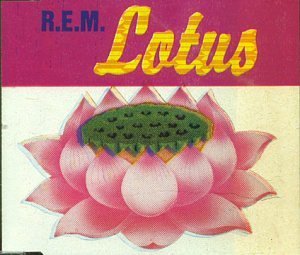
"Lotus" is a song by American rock band R.E.M., released as the second single from their eleventh studio album, Up (1998). The song is somewhat minimalist, with Michael Stipe singing surreal lyrics in a percussive manner. It builds on a four-note keyboard part, with a distorted guitar riff at the beginning and after the second chorus. The song's recurring line "I ate the lotus" appeared in an alternate form in a previous R.E.M. song, "Be Mine". The line "dot dot dot and I feel fine" is a reference to R.E.M.'s 1987 hit "It's the End of the World as We Know It ".

"All the Way to Reno (You're Gonna Be a Star)" is a song by American rock band R.E.M. It was released on July 23, 2001 as the second single from the band's twelfth studio album, Reveal (2001). The single did not chart on the US Billboard Hot 100, but it did reach number 24 on the UK Singles Chart, number 31 in Italy, and number 34 in Ireland.























